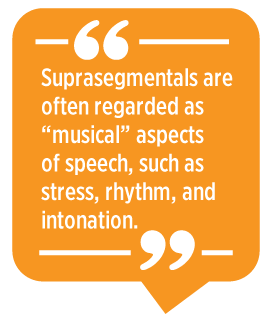
For most of us, we rely on our ability to express ourselves verbally significantly more than we rely on our writing skills. There has traditionally been an incongruity, then, in how little time is spent in the English language classroom developing speaking and pronunciation skills versus developing writing skills. One reason for this incongruity, perhaps, is that there has been less focus on establishing teaching methods with explicit learning objectives, practice, and specific feedback for developing speaking fluency than there has been for developing writing fluency. A second reason may be that, although theoretically effective teaching methods existed, the logistics of capturing and assessing individual student speech was tedious and time-consuming.
The Importance of Suprasegmentals
Fortunately, the instruction of speaking and pronunciation tends to be a standard topic covered in many TESOL teacher training programs these days, and explicit instruction has become commonplace in many classrooms. A commonly accepted claim in pronunciation pedagogy today is that suprasegmentals play a crucial and more critical role in communication—in addition to intelligibility—than segmentals (Hahn, 2004; Omidian & Siyanova‐Chanturia, 2020). Suprasegmentals are often regarded as “musical” aspects of speech, such as stress, rhythm, and intonation; they refer to more than one sound segment. In other words, in order for English learners to verbally communicate their ideas in English and to be understood, it is vital that pronunciation emphasis is put more on the suprasegmentals than on the pronunciation of the individual sounds of consonants and vowels.
Technology for Pronunciation Practice
To support the instruction of speaking and pronunciation, technological advances in automated speech recognition and ubiquitous access to digital audio recording has created possibilities to easily capture and review student speech and for students to access model pronunciation videos on demand (Elimat & AbuSeileek, 2014; Evers & Chen, 2020). These advances grant students autonomy and the opportunity to self-regulate the development of their pronunciation skills. They lower affective filters as students can practice at their own pace and can self-evaluate. Teachers benefit as the urgency of immediate teacher feedback is reduced.

In our classrooms, both virtual and face-to-face, we have had success with the following three pronunciation learning activities. The learning activities have engaged students, and improvement in pronunciation has been evident. The two types of free technology used in these learning activities are Google Voice Typing and Flipgrid. These learning activities are easily adaptable to any set of vocabulary.
Google Voice Typing
Google Voice Typing is a free online transcription tool available in Google Docs and Google Slides. Students use the tool to determine how intelligible their speech is. They speak into the microphone and see the tool type out what it has “understood.” Google Voice Typing has been documented as having 95% accuracy (McCrocklin & Edalatishams, 2020), which is similar to how well a native speaker might understand the nonnative speaker. See Appendix A (.docx) for instructions on how to enable Google Voice Type on your desktop.
Flipgrid
Flipgrid is a free video discussion tool created by Microsoft that can be accessed using a Microsoft or Google account. In these assignments, teachers use Flipgrid to post model pronunciation of the learning tasks, which is easily accessible with a simple link. Students record and rerecord their learning tasks until they are satisfied and then post to a different Flipgrid page. Sign up for a teacher’s Flipgrid account here.
Pronunciation Activities
Learning Activity 1: Pronunciation of Vocabulary in Context
Overview
This task
involves students listening several times to a teacher-created video sample,
speaking the sentences themselves, and reflecting.
Learning Objectives
-
Improve learner’s comprehensibility using new vocabulary.
-
Raise awareness of an individual's pronunciation challenges.
-
Increase familiarity with vocabulary, collocations, and use in context.
-
Practice pausing, emphasizing keywords, and stressing the appropriate syllable for improved comprehensibility.
-
Promote autonomy in working on pronunciation.
Steps
-
Create and post a video sample of the pronunciation of 10 sentences with the chapter vocabulary used in common contexts or collocations. Video is preferred over audio as it allows students to see the movements of the mouth.
-
Create a Google document using a three-column table: (1) your sentence (with words and syllables that should be stressed and with places that require a pause), (2) students’ pronunciation, and (3) student comments on any issues with pronunciation of particular words/phrases. See Appendix B for student handout.
-
Provide clear instructions and demonstrate how to use Google Voice Typing.
-
Students watch the video/teacher model. The first time, they watch and listen; the second time, they listen with a focus on syllable stress, keyword stress, pausing, and vowel pronunciation.
-
Students read the sentences aloud into Google Voice Typing. Encourage them to read each sentence several times to achieve accuracy but not more than three times so they can avoid too much frustration.
-
Students reflect in an online discussion, sharing what they learned.
Feedback/Assessment
-
Comment on a couple of students' issues.
-
Review common difficulties and indicate how those issues may be addressed. (See Rachel’s English for more exercises and videos on syllable stress, keyword stress, and so on.)
-
Give full marks to any student who did the assignment, regardless of accuracy.
Notes
-
You could include several sentences for more context, especially for advanced level students.
-
For lower levels, simple sentences should be used
Learning Activity 2: Pronunciation Differences Within Word Families
Overview
This task involves students reviewing vocabulary, listening to examples of the vocabulary read aloud, and posting a video that emulates your pronunciation.
Learning Objectives
-
Raise awareness of the pronunciation differences within word families.
-
Use the vocabulary in a sentence and raise awareness of grammar and collocations (word friends).
-
Analyze the value of using a teacher model and its value in helping students hear the differences in pronunciation within a word family.
Steps
-
Create Google slides reviewing vocabulary definition, word forms, and use in a sentence (see Appendix C) and a model video in which you read the vocabulary word, the sentence in context, and each of the high-frequency word forms. (See example model video here.) Video is preferred over audio as it allows students to see the movements of the mouth. The focus is on syllable stress and pronunciation of vowels (as they change depending on the stressed syllable) as well as on the rhythm in the sentence that uses the vocabulary.
-
Provide clear instructions and demonstrate how to use Flipgrid.
-
Have students review the Google slides in class (and on their own) and then listen to the model/video.
-
Students post a video on Flipgrid of themselves emulating your pronunciation. (See example student videos here and here.)
-
Encourage students to practice before they post and/or feel free to post on Flipgrid and delete until they are satisfied with their video.
-
Have students reflect in an online discussion about what they learned from the task.
Feedback/Assessment
-
Provide comments on Flipgrid, which allows for video and/or written feedback.
-
Feedback with encouragement along with a couple of suggestions works well.
-
Make notes of patterns/issues for future lessons.
Notes
-
For lower levels, the focus could be on word families, appropriate to the level.
-
On Flipgrid, you can include captions (recommended) on the instructor example video. The students can also check their own pronunciation using the closed captions that are created. However, the accuracy on Flipgrid is not as good as Google Voice Typing. It is not recommended unless the students’ pronunciation is at a very high level.
Learning Activity 3: Stress, Rhythm, and Intonation
Overview
In this
task, students read a passage from their textbook that has been marked for
stress and pauses, listen to a reading of the paragraph, and then post a video
of themselves reading the paragraph.
Learning Objectives
-
Increase awareness of what keyword stress, pausing, and intonation sound like.
-
Practice speaking with proficient rhythm with a heightened focus.
-
Gain an understanding of how the rhythm of English helps convey meaning.
-
Improve pronunciation by practice and self-evaluation (before recording).
-
Reflect on the process and the importance of rhythm.
Steps
-
Teach the basics of keyword stress, pausing, and intonation, and why this is important (see Rachel’s English for videos on word stress and linking and thought groups).
-
Create a handout with a paragraph from your textbook marked with bolded words (keywords) for stress (louder, longer) and pauses (//). Post a video of yourself reading the paragraph. (See an example here.) Video is preferred over audio as it allows students to see the movements of the mouth.
-
Provide clear instructions and demonstrate how to use Flipgrid.
-
Provide students with the passage, read it to the class, and point out how the rhythm helps convey meaning.
-
Have students view the posted video as many times as needed. Also ask them to notice and emulate the intonation.
-
Have students post their own video; encourage them to practice several times before posting. (See example student videos here and here.)
-
Students reflect on the process and their understanding of the value of stress, pausing, and intonation.
Feedback/Assessment
-
Provide comments on Flipgrid, which allows for video and/or written feedback.
-
Feedback with encouragement along with just a couple of suggestions works well.
-
Make notes of patterns/issues for future lessons.
Notes
-
Consider a subsequent lesson where students mark up the text themselves and post a video.
-
This is a high intermediate/advanced task.
Conclusion
Because the research clearly indicates the importance of suprasegmentals for nonnative speakers’ comprehensibility, and because automated speech recognition has improved dramatically, it is incumbent upon instructors to help our students take advantage of these tools and create more activities that foster student autonomy to work on stress, rhythm, and intonation as well as improve pronunciation with segmentals.
References
Elimat, A. K., & AbuSeileek, A. F. (2014). Automatic speech recognition technology as an effective means for teaching pronunciation. JALT CALL Journal, 10(1), 21–47.
Evers, K., & Chen, S. (2020). Effects of an automatic speech recognition system with peer feedback on pronunciation instruction for adults. Computer Assisted Language Learning, 1–21. https://doi.org/10.1080/09588221.2020.1839504
Hahn, L. D. (2004). Primary stress and intelligibility: Research to motivate the teaching of suprasegmentals. TESOL Quarterly, 38(2), 201–223. https://doi.org/10.2307/3588378
McCrocklin, S., & Edalatishams, I. (2020). Revisiting popular speech recognition software for ESL speech. TESOL Quarterly, 54(4), 1086–1097. https://doi.org/10.1002/tesq.3006
Omidian, T., & Siyanova‐Chanturia, A. (2020). Semantic prosody revisited: Implications for language learning. TESOL Quarterly, 54(2), 512–524. https://doi.org/10.1002/tesq.557
Gail Schwartz has taught academic and business English for nearly 20 years, subsequent to a career in marketing. During her 15 years at the UC Irvine Division of Continuing Education, she alternated quarters between teaching all levels and skills in their Intensive English program and teaching six courses in their Business English program. Ms. Schwartz now teaches adult ESL classes at Irvine Valley College, where she won the 2020 Associate Professor of the Year award. Ms. Schwartz has an MS in TESOL and an MS in urban and regional studies.
Dana Saito-Stehberger is a research specialist at UC Irvine Digital Learning Lab, where she is part of the Elementary Computing for ALL team, creating curriculum and supporting teachers as they teach computational thinking to English language learners. She has experience teaching English language learners for the past 25 years. Her interests include instructional design, integrating technology into teaching and learning, culturally relevant pedagogy, and the impact of collaboration on learning. She has an EdD in TESOL.
Rachel Fernandez has an MA in Spanish and a certificate in ESL. She has taught Spanish and English at high school, community college, and university levels. She has been an instructor at UC Irvine Division of Continuing Education since 2004, teaching a highly diverse student population in the English for Internationals programs and training teachers in the TEFL Certificate programs.
| Next Article |
